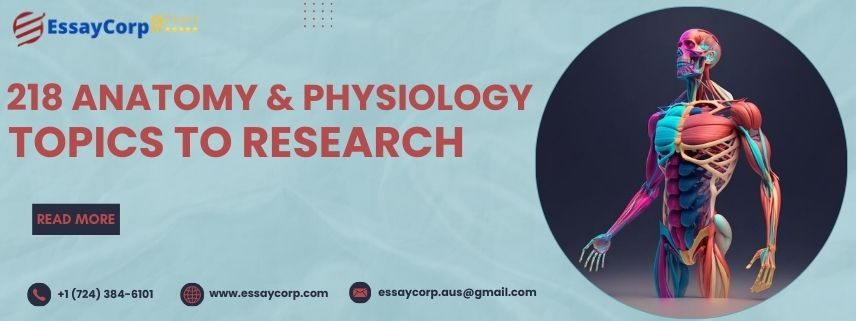The structure and function of biological systems are thoroughly investigated and clarified in study issues related to anatomy and physiology. These studies cover cellular processes, tissue architecture, organ functionality, and system interactions across different organisms. Prominent themes include neurophysiology, cardiovascular dynamics, endocrinology, musculoskeletal anatomy, respiratory physiology, and digestive mechanisms. More advanced topics cover genetic impacts on anatomical structures, the effects of diseases and aging on physiological functions, and the application of modern imaging techniques in anatomical studies. Additionally, this research addresses comparative and evolutionary perspectives on anatomy and physiology, paving the way for new insights into life processes. Consequently, research in anatomy and physiology not only advances our biological understanding but also improves human health and animal welfare.
The Building Blocks of Life: General Anatomy and Physiology
-
The Structure and Function of Cells
-
Tissue Types and Their Roles
-
The Human Skeletal System
-
Muscular System: Anatomy and Physiology
-
The Nervous System: An Overview
-
Cardiovascular System: Heart Anatomy
-
Blood Vessels and Circulation
-
Respiratory System: Lungs and Gas Exchange
-
Digestive System: From Ingestion to Excretion
-
Urinary System: Kidney Function and Homeostasis
-
Endocrine System: Hormones and Regulation
-
Reproductive System: Male and Female Anatomy
-
Immune System: Defense Mechanisms
-
Integumentary System: Skin, Hair, and Nails
-
Sensory Organs: Eyes and Ears
-
Homeostasis and Feedback Mechanisms
The Framework of the Body: Skeletal System
-
Bone Structure and Function
-
Types of Bones
-
Bone Development and Growth
-
Joint Types and Movements
-
Disorders of the Skeletal System
-
The Role of Calcium in Bone Health
-
Bone Remodeling and Repair
-
The Axial Skeleton
-
The Appendicular Skeleton
-
Common Bone Diseases: Osteoporosis, Arthritis
-
Bone Marrow and Hematopoiesis
-
Skeletal System's Role in Mineral Storage
The Movers of the Body: Muscular System
-
Muscle Fiber Types
-
Muscle Contraction Mechanisms
-
The Sliding Filament Theory
-
Energy Sources for Muscle Contraction
-
Neuromuscular Junctions
-
Muscle Fatigue and Recovery
-
Major Muscle Groups and Their Functions
-
Muscular Dystrophy and Other Disorders
-
The Role of Exercise in Muscle Health
-
Muscle Repair and Regeneration
-
Smooth, Skeletal, and Cardiac Muscle Differences
-
The Anatomy of a Muscle Cell
Command Center: Nervous System
-
Neuron Structure and Function
-
Neurotransmitters and Synapses
-
Central Nervous System: Brain and Spinal Cord
-
Peripheral Nervous System: Nerves and Ganglia
-
Autonomic Nervous System: Sympathetic and Parasympathetic
-
Reflex Arcs and Their Functions
-
Brain Regions and Their Functions
-
Disorders of the Nervous System: Parkinson's, Alzheimer's
-
Neuroplasticity and Brain Adaptation
-
Sensory Pathways and Perception
-
Motor Pathways and Movement Control
-
The Blood-Brain Barrier
Lifeline of the Body: Cardiovascular System
-
Heart Anatomy and Function
-
The Cardiac Cycle
-
Electrical Conduction System of the Heart
-
Blood Composition and Functions
-
Blood Pressure Regulation
-
Circulatory Pathways: Systemic and Pulmonary
-
Disorders of the Cardiovascular System: Hypertension, Atherosclerosis
-
The Role of Blood in Immune Response
-
Hemostasis and Blood Clotting
-
The Lymphatic System and Fluid Balance
-
The Impact of Exercise on Cardiovascular Health
-
Cardiac Output and Stroke Volume
Breath of Life: Respiratory System
-
Anatomy of the Respiratory System
-
Mechanics of Breathing
-
Gas Exchange in the Alveoli
-
Oxygen and Carbon Dioxide Transport
-
Regulation of Breathing
-
Respiratory System Disorders: Asthma, COPD
-
The Role of the Diaphragm in Respiration
-
The Impact of Altitude on Breathing
-
The Effect of Smoking on the Respiratory System
-
Pulmonary Circulation
-
Respiratory Volumes and Capacities
-
The Role of Surfactant in the Lungs
Fuel and Waste: Digestive System
-
Anatomy of the Digestive Tract
-
Digestive Enzymes and Their Functions
-
Nutrient Absorption in the Small Intestine
-
The Role of the Liver in Digestion
-
Metabolism and Energy Production
-
Disorders of the Digestive System: IBS, Crohn's Disease
-
The Gut Microbiome and Health
-
The Role of Fiber in Digestion
-
Hormonal Regulation of Digestion
-
The Process of Chewing and Swallowing
-
The Role of the Pancreas in Digestion
-
Bile Production and Fat Digestion
Waste Management: Urinary System
-
Kidney Anatomy and Function
-
The Nephron: Structure and Function
-
Urine Formation and Excretion
-
Regulation of Electrolytes and Fluid Balance
-
Acid-Base Balance in the Body
-
Disorders of the Urinary System: UTI, Kidney Stones
-
The Role of the Bladder in Urine Storage
-
Hormonal Control of Kidney Function
-
The Impact of Hydration on Kidney Health
-
The Role of the Urinary System in Blood Pressure Regulation
-
Renal Failure and Dialysis
-
Urinary Tract Infections: Causes and Prevention
Chemical Messengers: Endocrine System
-
Hormone Classification and Function
-
The Pituitary Gland: Master Gland
-
Thyroid Gland: Metabolism Regulation
-
Adrenal Glands: Stress Response
-
Pancreas: Insulin and Glucagon
-
Gonadal Hormones: Estrogen and Testosterone
-
Feedback Loops in Hormonal Regulation
-
Endocrine System Disorders: Diabetes, Hyperthyroidism
-
The Role of Hormones in Growth and Development
-
The Pineal Gland and Circadian Rhythms
-
Hormonal Control of Reproduction
-
The Impact of Hormones on Mood and Behavior
Creation of Life: Reproductive System
-
Male Reproductive Anatomy
-
Female Reproductive Anatomy
-
The Menstrual Cycle
-
Fertilization and Early Development
-
Pregnancy and Childbirth
-
Reproductive System Disorders: PCOS, Erectile Dysfunction
-
The Role of Hormones in Reproduction
-
Contraceptive Methods and Their Mechanisms
-
The Physiology of Sexual Response
-
Assisted Reproductive Technologies
-
The Impact of Aging on the Reproductive System
-
Genetic Inheritance and Reproduction
Defense Mechanisms: Immune System
-
Innate and Adaptive Immunity
-
White Blood Cells and Their Functions
-
The Lymphatic System and Immunity
-
Antibody Production and Function
-
The Role of the Thymus in Immunity
-
Autoimmune Disorders: Lupus, Rheumatoid Arthritis
-
Vaccination and Immune Memory
-
Allergies and Hypersensitivity Reactions
-
The Role of the Spleen in Immunity
-
Pathogen Recognition and Response
-
The Impact of Nutrition on Immune Function
-
Immunodeficiency Disorders: HIV/AIDS
Protective Barrier: Integumentary System
-
Skin Structure and Function
-
The Role of Melanin in Skin Color
-
Hair and Nail Anatomy
-
The Role of Sweat Glands in Thermoregulation
-
Skin Repair and Regeneration
-
Skin Disorders: Psoriasis, Eczema
-
The Impact of UV Radiation on Skin
-
The Role of the Skin in Vitamin D Synthesis
-
The Protective Functions of the Skin
-
Aging and the Integumentary System
-
The Role of the Skin in Sensation
-
Wound Healing Processes
Sensing the World: Sensory Organs
-
Anatomy of the Eye
-
The Process of Vision
-
Disorders of the Eye: Cataracts, Glaucoma
-
Anatomy of the Ear
-
The Process of Hearing
-
Balance and the Vestibular System
-
Taste and Smell: Chemoreception
-
The Role of Sensory Receptors
-
The Impact of Aging on Sensory Functions
-
Common Sensory Disorders: Tinnitus, Anosmia
-
The Neural Pathways of Sensation
-
The Integration of Sensory Information
Balancing Act: Homeostasis and Feedback Mechanisms
-
Negative Feedback Mechanisms
-
Positive Feedback Mechanisms
-
The Role of the Hypothalamus in Homeostasis
-
Thermoregulation in the Human Body
-
Blood Sugar Regulation
-
The Role of the Kidneys in Homeostasis
-
Fluid and Electrolyte Balance
-
The Impact of Stress on Homeostasis
-
Hormonal Control of Homeostasis
-
Homeostatic Imbalances and Disease
-
The Role of the Cardiovascular System in Homeostasis
-
The Interaction of Multiple Systems in Maintaining Homeostasis
Cutting-Edge Exploration: Advanced Topics
-
Stem Cells and Regenerative Medicine
-
Genetic Engineering and Gene Therapy
-
The Role of MicroRNAs in Gene Expression
-
The Impact of Epigenetics on Health and Disease
-
Personalized Medicine and Genomics
-
The Human Microbiome and Its Impact on Health
-
The Physiology of Aging
-
Biomechanics of Movement
-
Comparative Anatomy: Human vs. Other Species
-
The Impact of Space Travel on the Human Body
-
The Role of Biotechnology in Medicine
-
Advances in Diagnostic Imaging
Unique Perspectives: Special Populations
-
Pediatric Anatomy and Physiology
-
Geriatric Anatomy and Physiology
-
Pregnancy and Maternal Health
-
Sports Physiology and Performance
-
The Impact of Chronic Illness on Physiology
-
The Physiology of Mental Health Disorders
-
Gender Differences in Anatomy and Physiology
-
The Role of Nutrition in Health and Disease
-
Environmental Physiology: Adaptations to Extreme Conditions
-
Occupational Health and Physiology
-
The Physiology of Pain
-
Rehabilitation and Physical Therapy
On the Horizon: Emerging Research Areas
-
The Gut-Brain Axis
-
The Role of Exosomes in Cell Communication
-
Advances in Neuroscience and Brain Mapping
-
The Impact of Sleep on Health
-
The Role of Circadian Rhythms in Physiology
-
The Physiology of Addiction
-
The Role of the Endocannabinoid System
-
The Impact of Climate Change on Human Health
-
The Physiology of Longevity and Aging
-
Advances in Cancer Research
-
The Role of Artificial Intelligence in Medicine
-
The Impact of Technology on Health
Practical Applications: From Theory to Practice
-
Techniques for Dissecting and Studying Anatomy
-
Advances in Surgical Techniques
-
The Role of 3D Printing in Medicine
-
Telemedicine and Remote Monitoring
-
Wearable Technology and Health Monitoring
-
The Role of Robotics in Surgery
-
The Use of Virtual Reality in Medical Training
-
Advances in Prosthetics and Orthotics
-
The Impact of Lifestyle Choices on Physiology
-
The Future of Personalized Health Care
Conclusion
These subjects offer a wide range of anatomy and physiology research fields. There is a variety of information to be discovered, regardless of your interest in learning about the most recent developments in medical science or the basic workings of the human body. Explore these subjects in greater detail to gain a greater understanding of the wonders and complexity of human biology.



